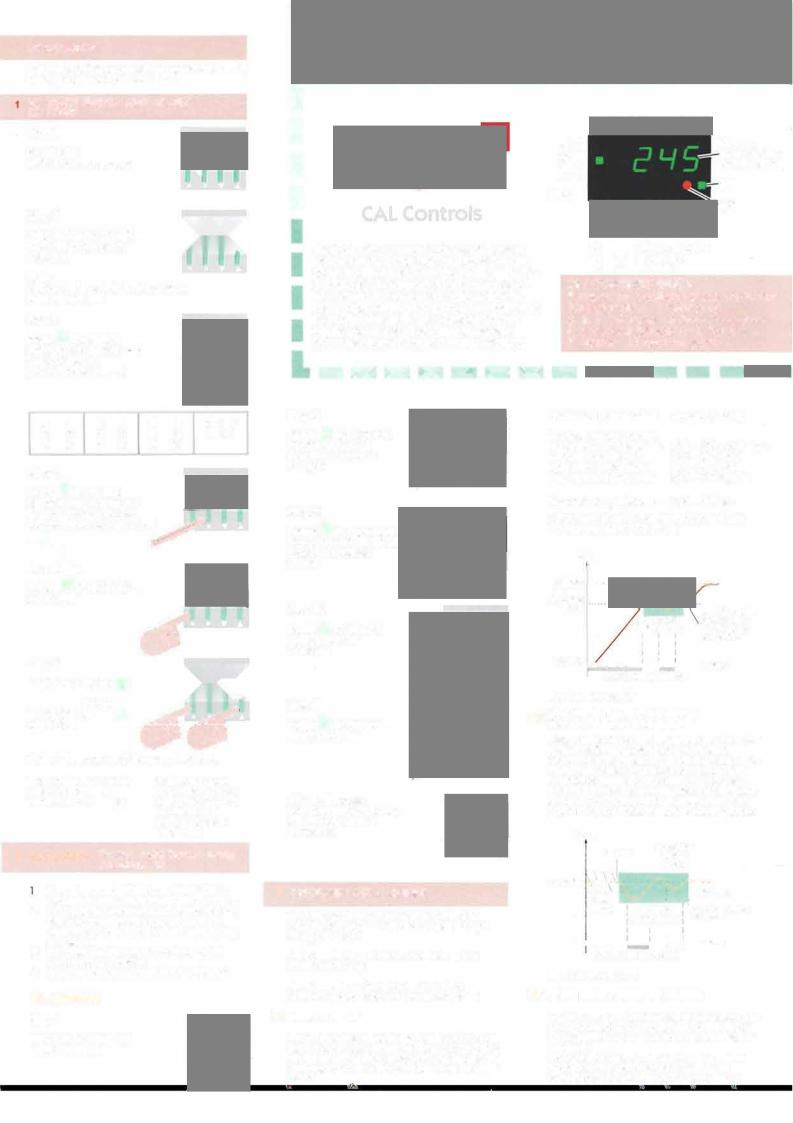CAL Controls 9900 Operating Manual

INSTALLATION
Install the 9900 controller in pone! see 10.2 Wire up connections see 10.1
TO SELECT SENSOR AND ADJUST
SET POINT
Step l
POWER UP
Self check sequence
Step 2 |
.. |
ZERO FLASHES ON LEFT |
|
Indicating no sensor |
|
selected |
|
Note
Buttons only adjust flashing digits
(shown green)
Step3
PRESS ATO SELECT SENSOR e.g. Type K 2 Sensor options:
(For full table see 8)
J |
l |
R |
4 |
E |
7 |
RTD 9 |
K |
2 |
s |
5 |
L |
8 |
Pnoo |
N |
3 |
T |
6 |
8 |
10 |
|
Step4
PRESS p TO ENTER SENSOR INTO MEMORY Qisploy shows process
temperature e.g. Ambien
Steps |
*TO DISPLAY |
PRESS |
|
SET POINT |
|
Step 6 |
|
($ |
|
.. |
|
PRESS AND HOLD |
* |
|
PRESS |
A |
|
TO INCREASE |
&& |
|
SET POJNT |
|
|
Output turns on and temperature rises |
||
The controller is now |
Prop bond 2.5% |
|
operational with |
|
Prop time 20 sec |
factory PIO settings: |
Derivative 25 sec |
|
|
|
Integral 5 min |
DAC approach control l.5
2 IMPORTANT - Please read before using Autotune AT
If required adjust: Range. Hi-res 0.1°. Negative temperature ranging, see 8
2 Proportional cycle-time: 20 sec factory set. if unsuitable change now or use Autotune calculated value otter tuning run see 6
3 For best results use normal set point and load conditions
4 Start Autotune AT with the load cool
TO AUTOTUNE
Step 7
START AUTOTUNE 'AT'
NEAR AMBIENT
I |
|
|
|
|
|
I |
Hi.&. |
|
|
|
Process |
I |
SP. |
|
|
|
temperature |
|
|
|
or set point |
||
|
LoT |
|
|
|
SPl |
I |
Error |
|
|
|
|
|
|
|
SP2 |
||
|
|
|
|
||
The CAL 9900 microprocessor based |
** |
|
View set point |
||
temperature controller provides precise |
ik |
.., |
Decrease |
|
|
control with a minimum of setting up, the |
.&. |
Increase |
|
||
advanced Autotune algorithm tunes all |
KEY CONTENTS GUIDE |
|
|||
five control parameters automatically. |
9 Important caution - please read first |
||||
The simple setting up procedure below is |
10 Installation |
1 Setting up |
|||
normally sufficient. specialised applic |
2, 3, 5 |
Autotune |
6 Prop cycle-time |
||
ations may need the comprehensive |
Functions: 4 Selection |
a Tobie |
|||
9900 features covered in this manual. |
7 Alarms |
11 Error messages |
|||
--------In Program Mode - Left of . is value, Right of . is parameter.
Step 8
PRESS p TO ACCESS PROGRAM MODE Function O flashes on right
Step 9*
PRESS TO CHANGE TO OPTION SELECTION Option O flashes
on left
Step 10
PRESS ATO SELECT
AUTOTUNE 'AT'
Option l
Step 11
,..,...,........ D T- r.TA ......,.
t'l(C;);) r' IV ;)l."\1(1
AUTOTUNE 'AT'
AT and Process temperature displayed alternately during Autotune
3 AUTOTUNE TYPES AND USES
Two types of Autotune are provided to ensure optimum control of a wide range of applications
AUTOTUNE AT - Normal method. tunes during warm up
AUTOTUNE PT-(Push-to-Tune)- For difficult applicolions. tunes at set point
3.1 AUTOTUNE AT
Start Autotune AT with the load cool. A short tuning cycle occurs at 75% set point during warm up. New PIO values ore automatically entered and the temperature rises to set point
Autotuned parameters |
|
Autotune limits |
||||
Entered automatically: |
|
0.5- 2C,'° c/ronge |
||||
Proportional band/Gain |
||||||
Integral time/Reset |
|
|
0.2 - 43.5 min |
|||
Derivative time/Rate |
|
|
l.0- 255 sec |
|||
DAC approach control |
|
0.5- 9.0 x gain |
||||
Proportional cycle time |
|
0.8- 819 sec |
||||
Calculated but for safety reasons needs |
||||||
manual acceptance see 6 |
|
|||||
temp |
|
|
|
|
|
|
setpotnt |
- |
|
|
|
|
|
ATIU1'4ng |
|
|
|
|
|
new PIO volues |
75'1. SP |
I'/, |
onloH |
||||
|
|
cycles |
entllred ona |
|||
|
lun,ng |
|
|
|
output power |
|
Start Ac.cT- |
l.L---..;.-'-- |
|
re·Oppl,ed |
|||
-- tme |
||||||
|
, |
|
, |
, |
|
|
|
(100'1. output powe<) |
|
||||
Fig. 1 Autotune AT
32 AUTOTUNE PT (Push-to-Tune)
•C.afa.,..f l"\""'t ') ,.f ? •+a.... 11""\ vv,v...,., "'""'' • ..,., • ••v,., ,....,
Used to fine tune difficult applications ot set point. Useful if the set point or thermal conditions are substantially changed. During PT tuning some overshoot will occur. If this is unacceptable, temporarily reduce set point. PT tunes the parameters listed above except DAC. Proportional cycle time is re calculated but needs manual acceptance
remp |
|
overshoot |
|||
|
Siert PI |
|
|||
|
|
dtJr,ng |
|||
setpotnt |
: |
|
tuning |
||
|
|
· |
· |
||
|
\ \ |
- |
tuning PIO |
||
|
P<OO |
I'/, on/ott |
new PIO volues |
||
|
bond |
||||
|
|
tuning |
|
I |
I ente<ed |
|
|
|
cycles |
|
|
-+---'-,- - --'--hme |
|||||
|
|
, |
|
|
|
|
(100'1. output Power) |
|
|||
Fig. 2 Autotune PT
3.3 OVERIDING AUTOTUNE VALUES
After AT/PT any Autotuned parameter moy be changed to an Option from the table. The original Autotuned value is retained in memory.
Note Subsequent Autotune AT or PT run replaces manual selections with new calculated values (except Cycle time)


